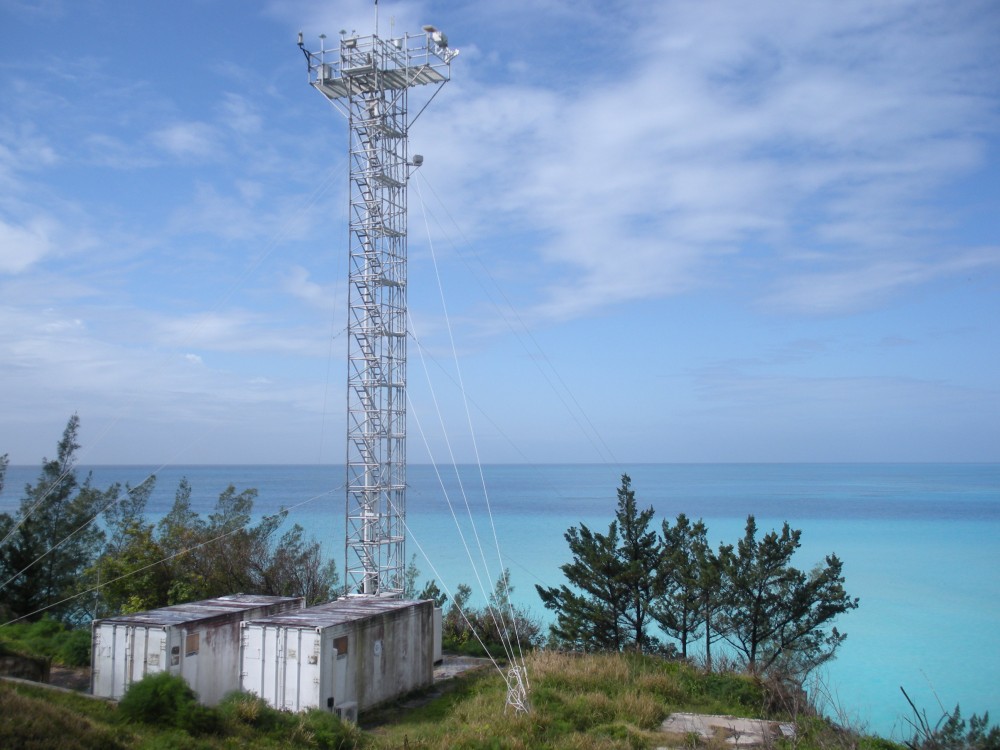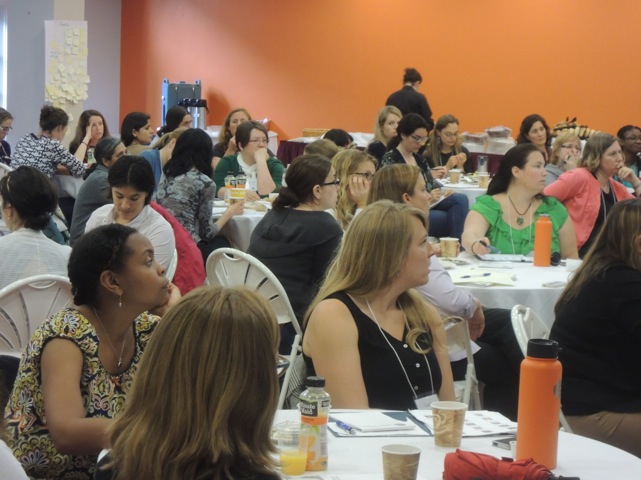Associate Professor Meredith Hastings has been studying nitrogen for over a decade. Why? "Sometimes I think it's because nitrogen wasn't carbon," she laughs.
But as Hastings knows, nitrogen is just as important to scientists' understanding of climate change, both today and in Earth's distant past.

78% of our atmosphere is made up of nitrogen in the form of non-reactive N2 gas. Organisms break apart, or "fix," this nitrogen in a variety of ways in order to make it usable. The result is a variety of bioavailable chemicals like ammonia and nitrogen oxides, which are far easier for the organism to consume as fuel or to employ as fertilizer.
But so-called reactive nitrogen species can have serious consequences for ecosystems unaccustomed to such massive quantities of free food. Environmental casualties like smog, acid rain, and mass fish die-offs in coastal waterways are often attributable to the rise of reactive nitrogens, or NOx, in our atmosphere.
Hastings believes that scientists have much to learn by studying nitrogen more closely—specifically, the relationship between two forms of nitrogen, N-14 and N-15. These two types of nitrogen are known as different isotopes, because although they exist as the exact same element, there is one crucial difference: N-15 has an extra neutron. This atomic mismatch causes the two species to interact with elements of the environment in different ways.
Furthermore, explains Hastings, "the behavior of them relative to each other, of N-14 relative to N-15, seems to be different for human-made sources than biologically made sources."
As a graduate student, Hastings learned to quantify the isotopic signatures of reactive nitrogen in different environments with great precision. Then, in 2014, her lab here at Brown pioneered a novel method for isolating the isotopic composition of NOx. If she and her team can combine these techniques to successfully collect and "fingerprint" the reactive nitrogen present at different times in the geological record, they will have a better map with which to trace the influence of various formulations of this element both in the modern day and in the distant past.
"I'm excited to understand how the environment changes and how the environment responds to these different pressures," she says. "You have natural changes that put pressures on the system through changes in climate, and then you have these different human pressures on the system."
"I'm fascinated by the fact that we can develop records under conditions where there wasn't really a big human influence," she continues, "but that we also have this difference today to compare to and think about."
Multiple projects

A biogeochemist by trade, Hastings has always had her hand in multiple projects. As a graduate student, she began her studies by performing ocean chemistry research in Bermuda, with a project whose results still surprise researchers to this day. Since arriving at Brown in 2008, she has been awarded a variety of internal funds and external grants, including the National Science Foundation's prestigious CAREER Award, which supports her analysis of isotopic signatures of nitrogen in gases emitted here in the United States by both natural (soils) and anthropogenic (automobiles) sources.
Hastings was involved in similar nitrogen work in Greenland during graduate school and is now extending the project even further, leading teams that are collecting ice cores from Antarctica and analyzing sea water in the Pacific.
She was also instrumental to the implementation of a University of Virginia-developed Nitrogen Footprint Project here at Brown.
But her work doesn't stop at the four walls of the University. Hastings is also co-founder of the internationally-known Earth Science Women's Network (ESWN), the first society founded primarily for early career women scientists. What began as an informal group of about a dozen female graduate students who met during lunch breaks at conferences ballooned in a matter of years to an organization with thousands of members in diverse fields, from atmospheric chemistry to oceanography to biogeochemistry.
"The reason this started was that we all found that peer mentoring was really beneficial," says Hastings. "We really liked having someone who, even though they might be at a different school or have a different adviser, was somehow experiencing similar issues."
A supportive environment
Hastings explains that, despite growing numbers of female faculty in the sciences, women are still relatively absent from the highest ranks of academia and continue to fall short of men when it comes to being nominated for professional awards.
ESWN aims to reverse these trends by bringing women in the earth sciences together, both in the virtual sphere and at Network-sponsored professional development workshops. The shortest of these workshops often take place at large conferences like AGU and tackle crowd-sourced topics such as communicating and networking, defining one's research identity, and developing leadership and management skills.
ESWN also partners with external facilitators to lead longer, 3-day workshops that focus more intensively on such topics at different locations around the country.

But membership in the Earth Science Women's Network is not limited to career-level scientists. Indeed, the organization is currently working toward broadening participation among female undergraduates, especially those from historically underrepresented groups. Members of these groups tend to have less access to networks, and therefore less professional support.
ESWN hopes to bolster that support. "Just the fact that ESWN exists means that there's this resource out there," says Hastings. "Maybe I'm the only woman in my program or the only woman professor in my department, but now I've tapped into this network and so I feel like I have a community."
The oft-cited solution to increasing the number of women in science is to widen the pipeline, especially at the undergraduate level and younger; however, Hastings understands that there can be unexpected hurdles to overcome when targeting youth—such as the fact that young people do not always have a good sense of what earth scientists do.
"If you're young and good at science, you're told to be a doctor," she says. "So the medical fields have a bit more access… We need to do a little bit of promotion of our field in general in order to gain more interest."
Looking toward the future
ESWN is currently in the midst of a fundraising campaign designed to ensure its long-term sustainability. In December 2015, the organization was awarded a grant through the Wisconsin Matching Foundation that will support its goal of raising an endowment fund to cover general operating expenses.
In the future, Hastings and other members of the leadership board are hopeful that such an endowment will enable them to offer a greater number of workshops and engage in more in-depth outreach activities.
Asked what she ultimately hopes ESWN will achieve, Hastings smiles.
"The real answer to that question is that I hope someday ESWN doesn't need to exist, because that would mean that women feel like they have enough community around them, they have enough support around them, they have easy access to the resources that we offer, they don't feel the need to be a part of an a organization like that."
"So to me, that would mean that we've come full circle," she continues. "That women now feel like they have plenty of resources and support and community. That would be awesome."
But ESWN's value extends beyond its role as a resource to female scientists alone.
"I've always thought that the immediate goal was having women find the resources that were helpful to them through us, through the network," explains Hastings. "But I think the bigger goal is being that resource to the rest of the community, of saying, 'Look, you want to know the answer to how to get more women into your institution, or what the issues are with your institution? I can send an email to three thousand women right now and get an answer for you.' And I think that we're starting to see that happen."
Although improving women's ranks in the world of academia is a central part of the organization's mission, ESWN's wider goal is to give women the tools they need to feel empowered and succeed in whatever field they choose to work in.
"I don't think everyone has to become a scientist, and I certainly don't think that everyone who gets a PhD has to be a professor," she says. "But I want them to feel like they have access and the ability to accomplish what they want to accomplish regardless of their gender."
But for her part, Hastings greatly enjoys being a scientist. And she knows firsthand how early mentorship can nourish enthusiasm for the subject.
"I mostly give credit to an 8th grade science teacher I had, who was an oceanographer by training," she says. "He related everything he was teaching us in this physical science class to the ocean."
Science, and earth science in particular, is filled with opportunities for young people of all backgrounds to deepen their firsthand experience of the world by learning more about how it works. Hastings hopes that her own research and her work with ESWN will encourage other budding women scientists to want to engage with their surroundings in the same way as she did.
"As a young student, I just ate it up," she explains, "Because he was applying these seemingly very dry, boring equations and theories to something that I loved and could touch and feel and see. That was what I wanted to be able to understand and apply to the world around me."